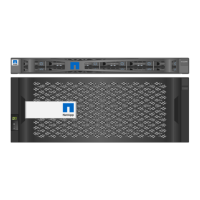Port bond
mode
Network bond
mode
Client Network disabled
(default)
Client Network enabled
Fixed
(default)
Active-
Backup
(default)
• Ports 2 and 4 use an
active-backup bond
for the Grid Network.
• Ports 1 and 3 are not
used.
• A VLAN tag is
optional.
• Ports 2 and 4 use an active-
backup bond for the Grid
Network.
• Ports 1 and 3 use an active-
backup bond for the Client
Network.
• VLAN tags can be specified
for both networks for the
convenience of the network
administrator.
LACP
(802.3ad)
• Ports 2 and 4 use an
LACP bond for the
Grid Network.
• Ports 1 and 3 are not
used.
• A VLAN tag is
optional.
• Ports 2 and 4 use an LACP
bond for the Grid Network.
• Ports 1 and 3 use an LACP
bond for the Client Network.
• VLAN tags can be specified
for both networks for the
convenience of the network
administrator.
Aggregate LACP
(802.3ad) only
• Ports 1-4 use a single
LACP bond for the
Grid Network.
• A single VLAN tag
identifies Grid Network
packets.
• Ports 1-4 use a single LACP
bond for the Grid Network
and the Client Network.
• Two VLAN tags allow Grid
Network packets to be
segregated from Client
Network packets.
See “10/25-GbE port connections for the SG6000-CN controller” for more information about port
bond and network bond modes.
Steps
1. From the menu bar of the StorageGRID Appliance Installer, click Configure Networking > Link
Configuration.
The Network Link Configuration page appears. The first time you access this page:
• Link Speed is set to 10GbE.
• Port bond mode is set to Fixed.
• Network bond mode is set to Active-Backup.
• The Admin Network is enabled.
• The Client Network is disabled.
46
| Hardware Installation and Maintenance Guide for SG6000 Appliances

